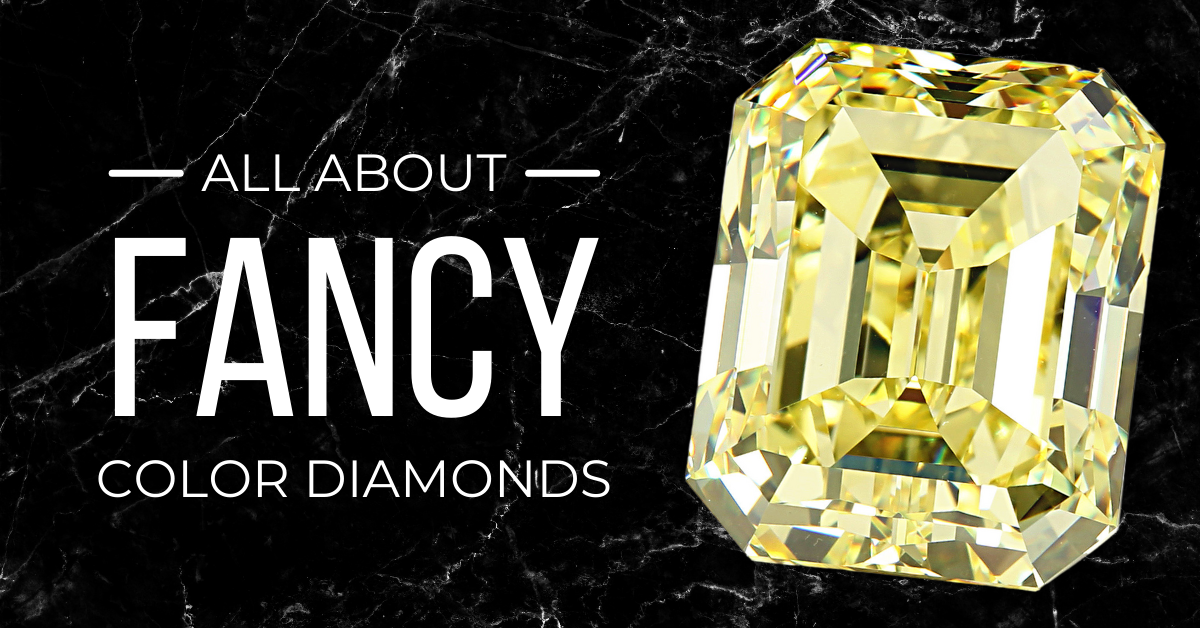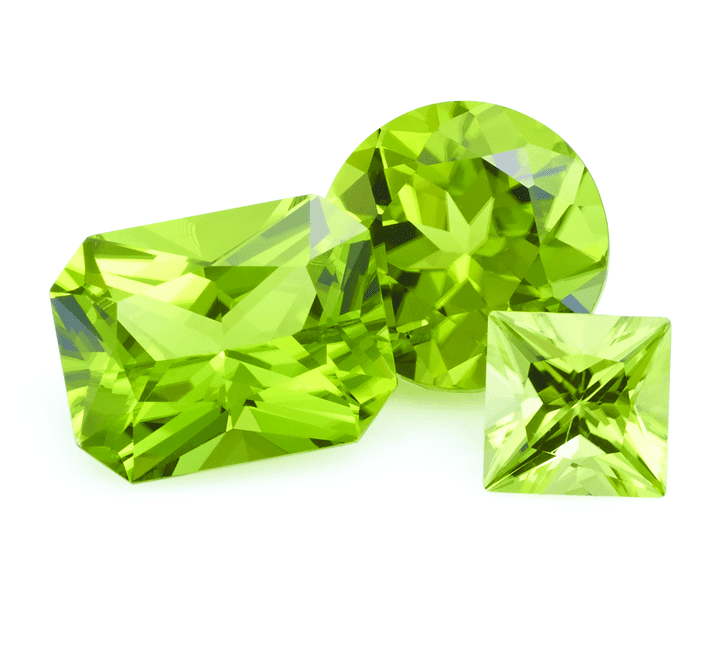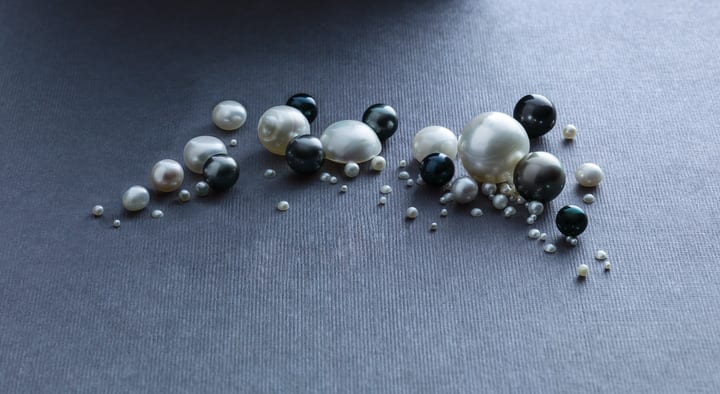Are you looking for a unique twist to the traditional diamond? Then, we have just the stone for you, no matter what your favorite color is. Read on to learn more about fancy color diamonds! About The Fancy Color Diamond According to GIA, a diamond falls under the category of fancy color if it is yellow or brown beyond the GIA D-Z color grading scale or diamonds that exhibit any other color face-up. This includes colors like red, green, blue, pink, and even black. If you’ve read our post about the four C’s of diamonds, you’ll know that white diamonds typically fetch a higher price. However, the opposite is true of Fancy Color Diamonds. The stronger that color is, the more valuable the gem will be. However, if you want more bang for your buck on a fancy, go for a yellow or brown. They aren’t as “desirable” as some other colors, but they sparkle just as much! Famous Fancies The world’s most famous diamond, The Hope Diamond, is a fancy color diamond. It’s a 45.52-carat diamond, and its color has been most recently described as fancy dark grayish-blue. It has a storied history spanning back to the late 1600s. Famous owners of this gem include Marie Antoinette and Louis XIV. It is on display in the Smithsonian National Museum of Natural History in Washington, D.C today. The Black Orlov diamond is another well-known fancy, with a history as dark as the stone itself. Some say the diamond is cursed — it’s even rumored to be responsible for three suicides throughout the first half of the 20th century. Charles F. Winson purchased the gem in the 1950s and chose to break its (alleged) curse by cutting the diamond into three pieces. The 67.50-carat cushion-shaped diamond is on display in the American Museum of Natural History; however, the whereabouts of the remaining diamonds are a mystery. Fancy Origins Diamonds with fancy colors have traditionally been a small part of the jewelry business, but their popularity has grown over the past few decades. Most come from India, South Africa, and Australia, but other mines in Brazil, Venezuela, and Indonesia produce fancy color diamonds. How are fancy color diamonds made? During a natural diamond’s creation, trace elements such as nitrogen, sulfur, and boron and color diamonds in shades of yellow, green, and blue. However, you won’t find trace chemical elements in pink diamonds. Instead, “the color is caused by a distortion in the diamond’s crystal lattice, created by intense heat and great pressure from all directions after the stone’s formation,” according to the Victoria Museum in Australia. The distortion misplaces many carbon atoms from their normal positions and alters the qualities of light that allows us to observe the stone as pink. Whether you’re looking for a white diamond or a fancy color stone, we have the best selection in DFW. Come see why we’ve stood the test of time at the original Dallas Gold & Silver Exchange.
Tag Archives: gemstones
June isn’t the only month that gets three birthstones. Bestowed upon those with August birthdays are the gemstones peridot, sardonyx and spinel. Each gemstone is vastly unique from the other and gives August babies a number of options to choose their perfect look! Read on for details on each August birthstone. Peridot Peridot is the primary August birthstone. A gem variety of the mineral olivine, peridot ranges from yellowish green to greenish yellow and has been often mistaken for emerald and topaz throughout history. In fact, some historians speculate that Cleopatra’s vast emerald collection was actually comprised (partially) of peridot. Not only is peridot the August birthstone, but it’s also the 15th anniversary gemstone. This is a great gift option for every budget, depending on the size of the peridot. While large, grass-green peridots are more expensive, there are plenty of smaller stones that would fit a smaller budget. Sardonyx Sardonyx is the original gemstone — the OG, if you will — assigned as the August birthstone. When peridot joined the party, it became the primary August birthstone ahead of sardonyx. As the name suggests, sardonyx combines alternating layers of sard and onyx. These two types of mineral chalcedony separate to create reddish and white zerbra stripes. The finest examples of sardonyx display sharp contrasts between layers. According to the American Gem Society, “sardonyx is widely available and relatively inexpensive as gems, beads, and jewelry. It is often carved into cameos, intaglios, and brooches to show the color contrast between layers.” Spinel Remember how we said the ruby is the most valuable colored gemstone besides diamonds? Well, if you’re looking for a budget-friendly option for a ruby, that’s where the spinel gemstone comes in handy. It comes in a wealth of colors, including intense red, and is less pricey. Often mistaken for other gemstones throughout history, the spinel has been dubbed “the great imposter.” In fact, one of the most famous “rubies” in the world, the Black Prince’s Ruby, in the British Imperial Crown is actually a red spinel. Not only is the gemstone strikingly beautiful, it carries great historical meaning. Just how great is its historical meaning? We can thank spinel for the study of gemology! As a result of the spinel’s similarity to ruby, people began to study the gemstones and their differences. Without spinel, we may not even have birthstones!
Lucky you, June babies! You have not one, not two, but THREE lovely gemstones to choose from as your birthstone. Most consider pearls as the primary birthstone for the month of June, while Moonstone and Alexandrite are alternatives. All of these stones are rich in their own unique beauty and history. Keep reading to find out more about your lovely birthstones and why you get more than one. Why are there three June birthstones? The Jewelers of America put together the first official list of birthstones in 1912, listing only Pearl and Moonstone for June. It wasn’t until 1952 that Alexandrite was added to the June birthstone list. We guess three was just the lucky number for June! Pearl Like other gemstones, pearls form naturally, slowly for as long as two decades. Unlike other gemstones, mollusks, such as oysters and clam create pearls. Depending on what part of the world the mollusk is from, it changes the pearl type. Due to their rarity and difficulty to find, natural pearls have remained an expensive stone since ancient times. They were revered among royalty and nobility alike and symbolized purity, integrity and love. Moonstone When we say “gemstone,” moonstone may not be the first one that comes to mind. They aren’t as popular as pearls, but we think they are a modern, beautiful alternative. Their adularescence is the first thing you’ll notice in the moonstone. According to GIA, “adularescence is the light that appears to billow across a gemstone, giving its surface a glowing appearance.” Visually, the glow has a moon-like quality, which is where the name moonstone comes from. In the picture above, you can see a moonstone both in its rough form and polished. FUN FACT: The moonstone is the Florida State Gemstone to commemorate the moon landings that took off from Kennedy Space Center. Alexandrite The Alexandrite is one of the newer gemstone discoveries. It was discovered in the Russian Ural Mountains in 1830 and wasn’t added to the birthstone list until 1952. Known as the chameleon of the gemstone family, it’s an “emerald by day, ruby by night” due to its color-changing tendencies. It’s bluish-green in daylight and reddish-purple in lower light. Due to its toughness on the Mohs scale, it makes a great option for rings or bracelets. Just be sure to clean it with warm, soapy water. If you enjoy our gemstone spotlights, follow us on this blog, Instagram and Facebook. Did you miss our May Birthstone Spotlight? Check it out here!



